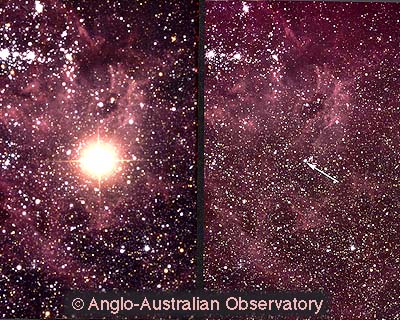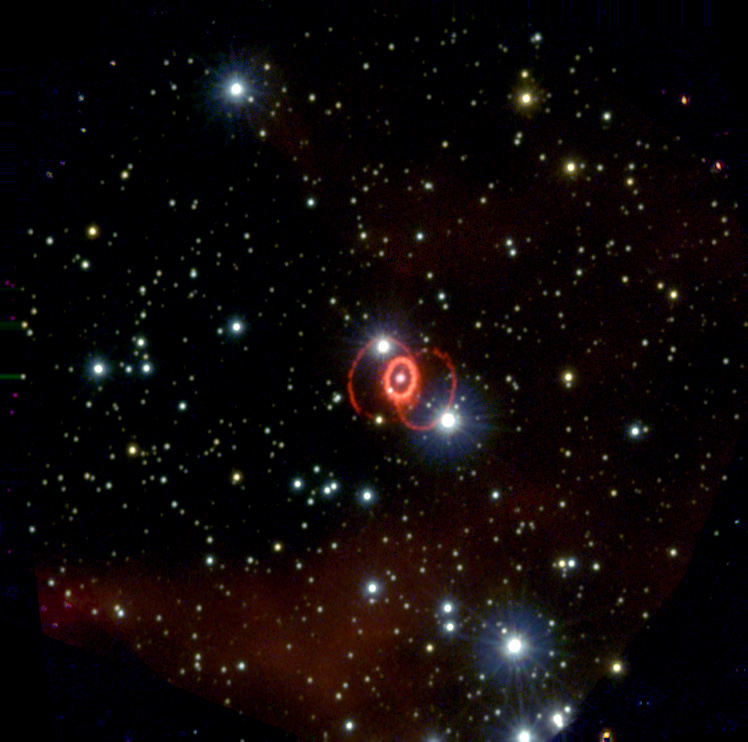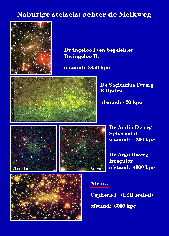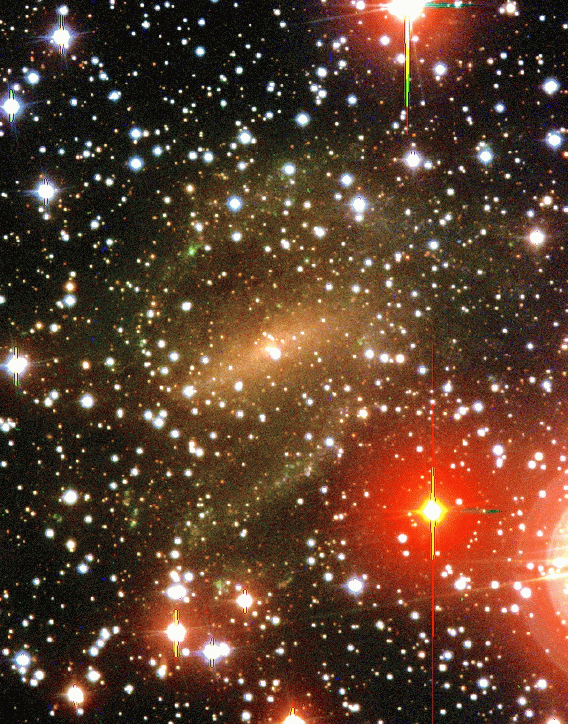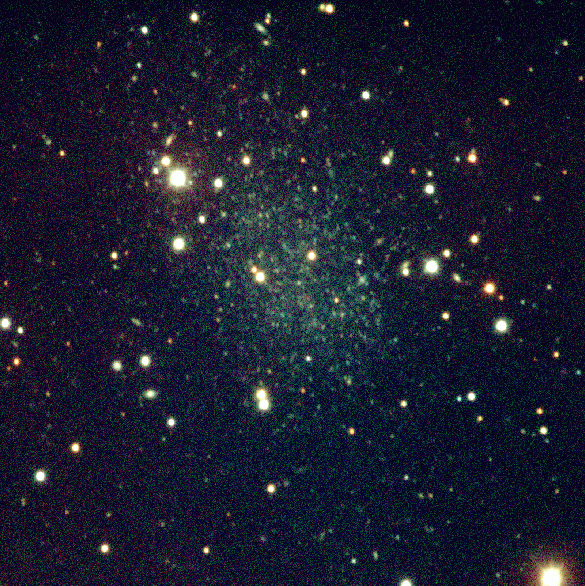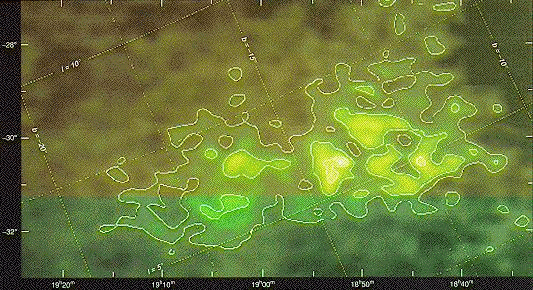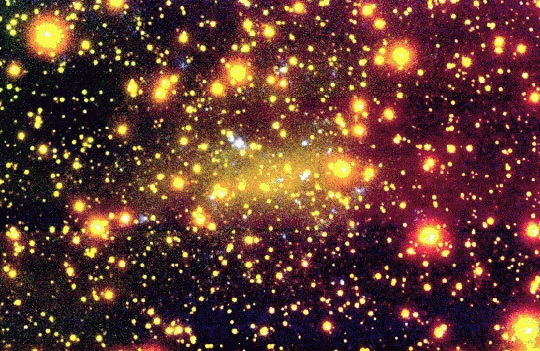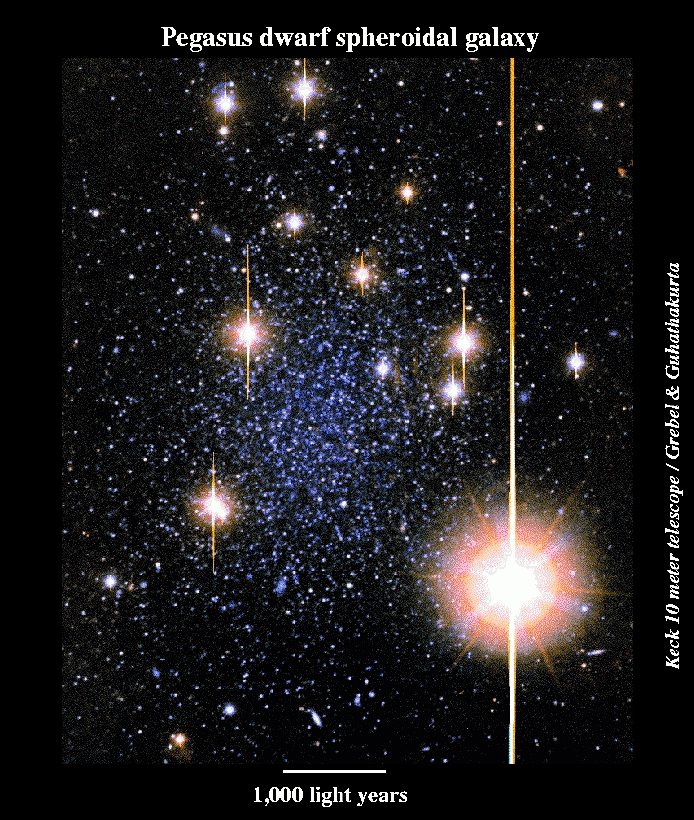Our Milky Way Galaxy and its companions
A fisheye view of the Southern Sky
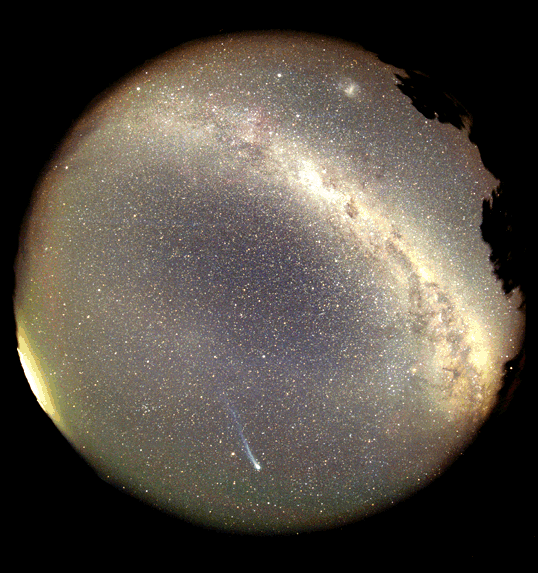
Credit and Copyright: G. Garradd
The Milky Way Galaxy - A spiral galaxy, type SBbc, centered in Sagittarius
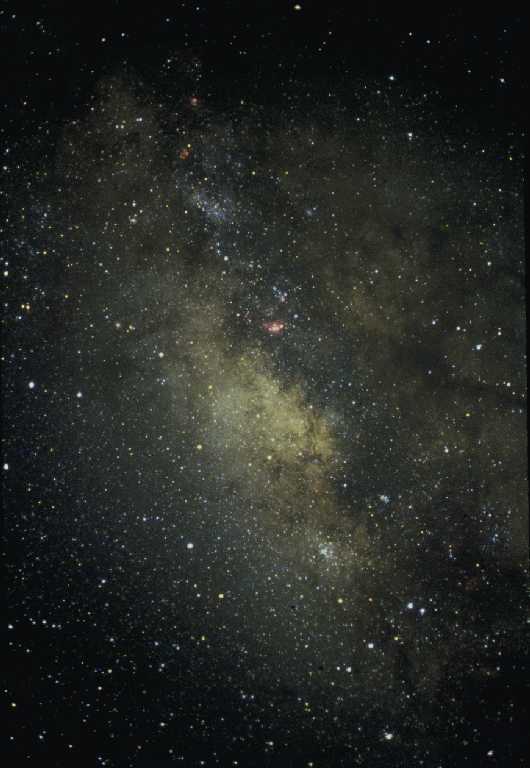
Credit: W. Keel (U. Alabama in Tuscaloosa), Cerro Tololo, Chile
The Milky Way is the galaxy which homes our Solar System together with at least 200 billion other stars and their planets, and thousands of clusters and nebulae including at least almost all objects of Messier's catalog which are not galaxies on their own (the only possible exception may be M54 which may belong to SagDEG, a small galaxy which is currently in a close encounter with the Milky Way, and thus our closest known intergalactic neighbor). All the objects in the Milky Way Galaxy orbit their common center of mass, called the Galactic Center (see below).
As a galaxy, the Milky Way is actually a giant, as its mass is probably between 750 billion and one trillion solar masses, and its diameter is about 100,000 light years. Radio astronomial investigations of the distribution of hydrogene clouds have revealed that the Milky Way is a spiral galaxy of Hubble type Sb or Sc. Recent evidence, particularly from the DIRBE instrument aboard COBE, convincingly shows our galaxy to be a barred (SB) rather than a regular spiral (S).
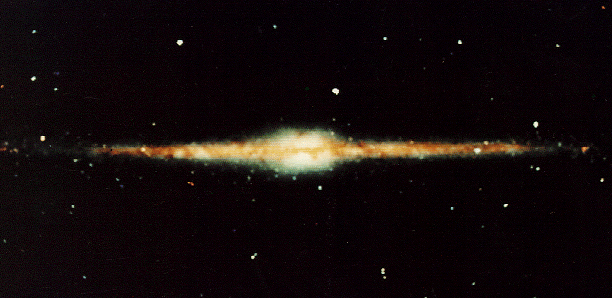
Credit: COBE/DIRBE - NASA/Goddard Space Flight Center
Milky Way pictures are wide-field exposures. Besides being attractive and often colorful, they are often suited to view the Milky Way objects (including nebulae and star clusters) in their celestial surroundings of field stars.
Below we give some data for the Galactic Center:
Right ascension 17 : 45.6 (h:m) Declination -28 : 56 (d:m) Distance 28 (kly) The Galactic North Pole is at: Right ascension 12 : 51.4 (h:m) Declination +27 : 07 (d:m)Our Sun, together with the whole Solar System, is orbiting the Galactic Center at the distance given, on a nearly circular orbit. We are moving at about 250 km/sec, and need about 220 million years to complete one orbit (so the Solar System has orbited the Galactic Center about 20 to 21 times since its formation about 4.6 billion years ago).
Considering the sense of rotation, the Galaxy, at the Sun's position, is rotating toward the direction of Right Ascension 21:12.0, Declination +48:19. This shows that it rotates "backward" in the Galactic coordinate system, i.e. the Galactic North Pole is actually a physical South Pole with respect to galactic rotation.
The coordinate data given here were extracted from the online coordinate calculator at Nasa's Extragalactical Database (NED).
The Lund Observatory map of our Milky Way Galaxy
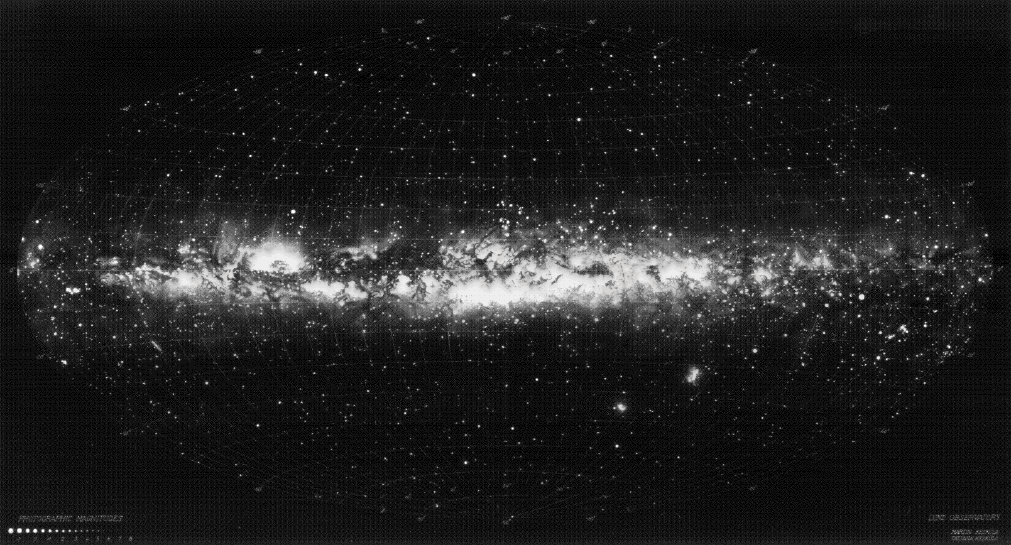
Credit: Knut Lundmark, Copyright: Lund Observatory
7,000 Stars And The Milky Way
This panorama view of the sky is really a drawing. It was made in the 1940s under the supervision of astronomer Knut Lundmark at the Lund Observatory in Sweden. To create the picture, draftsmen used a mathematical distortion to map the entire sky onto an oval shaped image with the plane of our Milky Way Galaxy along the center and the north galactic pole at the top. 7,000 individual stars are shown as white dots, size indicating brightness. The "Milky Way" clouds, actually the combined light of dim, unresolved stars in the densely populated galactic plane, are accurately painted on, interrupted by dramatic dark dust lanes. The overall effect is photographic in quality and represents the visible sky. Can you identify any familiar landmarks or constellations? For starters, Orion is at the right edge of the picture, just below the galactic plane and the Large and Small Magellanic Clouds are visible as fuzzy patches in the lower right quadrant.
Compare this drawing with:
A photographic mosaic of the Milky Way
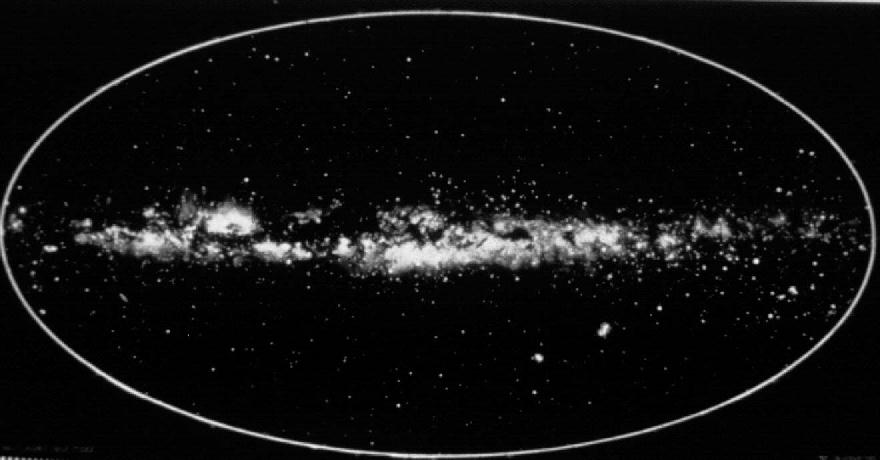
Milky Way photomosaic, contributed to the Usenet group alt.binaries.pictures.astro by Lloyd Johnson
A Magellanic Mural
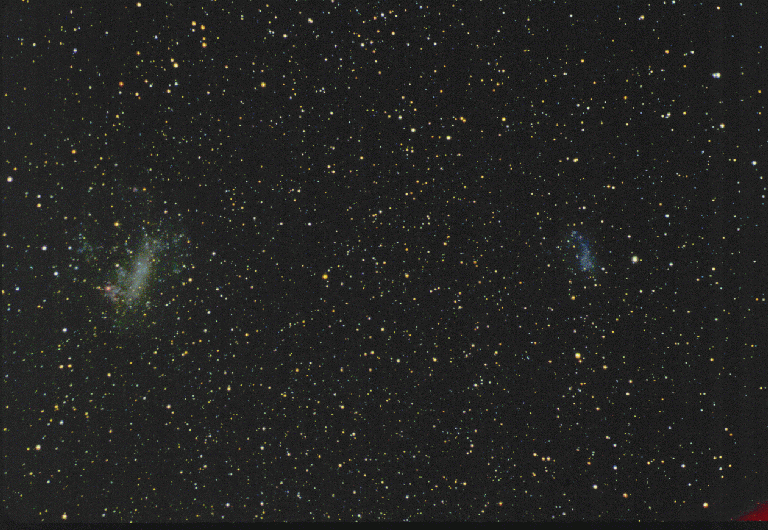
Credit: W. Keel (U. Alabama in Tuscaloosa), Cerro Tololo, Chile
The Large and Small Magellanic Clouds
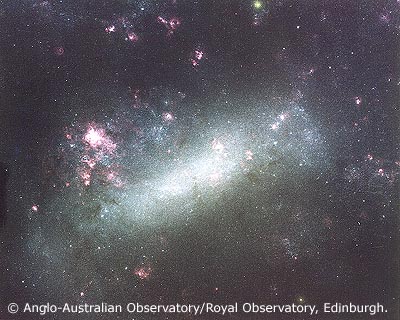
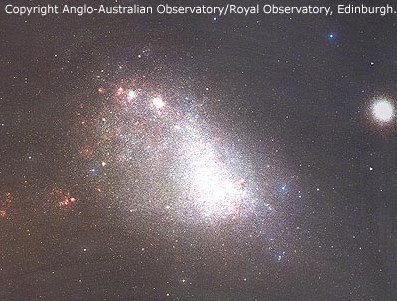
Credit & Copyright: D. Malin (AAO), AATB, ROE, UKS Telescope
Almost unknown to casual observers in the northern hemisphere, the southern sky contains two diffuse wonders known as the Magellanic Clouds. The Magellanic Clouds are small irregular galaxies orbiting our own larger Milky Way spiral galaxy. The Small Magellanic Cloud (SMC), pictured here, is about 250,000 light years away and contains a preponderance of young, hot, blue stars indicating it has undergone a recent period of star formation. There is evidence that the SMC is not gravitationally bound to the LMC.
AAO image reference UKS 14.
(c) Anglo-Australian Observatory/Royal Observatory, Edinburgh
Photograph from UK Schmidt plates by David Malin, text ) David Malin.
The image in this page was obtained by David Malin with the
Anglo-Australian Telescope. This image is copyrighted and may be used
for private purpose only. For any other kind of use, including internet
mirroring and storing on CD-ROM, please contact Coral Cooksley of the
Anglo Australian Observatory.
The Large Magellanic Cloud, LMC
Irregular Galaxy LMC, the Large Magellanic Cloud in Dorado
Right Ascension 5 : 23.6 (h:m) Declination -69 : 45 (d:m) Distance 179.0 (kly) Visual Brightness 0.1 (mag) Apparent Dimension 650x550 (arcmin)The Large Magellanic Cloud, together with its apparent neighbor and relative, the Small Magellanic Cloud, are conspicuous objects in the southern hemisphere, looking like separated pieces of the Milky Way for the naked eye. They were certainly known since the earliest times by the ancient southerners, but these people produced little documents which are still preserved. So it was Magellan and his discovery expedition who brought them to our knowledge in 1519.
Both Magellanic Clouds are irregular dwarf galaxies orbiting our Milky Way galaxy, and thus are members of our Local Group of galaxies. The Large Magellanic Cloud, at its distance of 179,000 light years, was longly considered the nearest external galaxy, until in 1994, the Sagittarius Dwarf Elliptical Galaxy was discovered at only about 80,000 light years. (Our current distance value takes into account the corrected Cepheid distance scale based on the Hipparcos satellite data published in early 1997.)
LMC is less than one tenth as massive as the Milky Way; even so it contains the equivalent of over ten billion solar masses of material in the form of stars, gas and dust. The nearness of the LMC ensures that it is well resolved into stars in quite a modest telescope, and deep photographs reveal it to be a highly complex system with large numbers of clusters, nebulae and dust clouds scattered apparently at random across the face of the galaxy. Although a small irregular galaxy, the LMC is full of interesting objects including diffuse nebulae (especially the Tarantula Nebula, NGC 2070 / 30 Doradus -- the bright red patch at the eastern end of the galaxy --, a giant H II region), globular and open clusters, planetary nebulae, and more.
Left: Credit: D. Malin (AAO). LMC showing Supernova SN1987A in its full splendor, and the same patch of sky prior to the explosion. Right: Credit: P. Challis (CfA)/ HST. Ten years after the SN explosion the expanding ejecta eerilly glow in the dark. The two outer rings consist of gas ejected by strong winds from the stellar surface in an earlier stage, before it exploded.
On February 24, 1987, supernova 1987A occurred in the Large Magellanic Cloud, which was the nearest observed supernova since Keplers, which occured before the invention of the telescope. Supernova 1987A, peculiar and of type II, was one of the most interesting objects for the astrophysicists in the 1980s (some even say of this century).
The Small Magellanic Cloud, SMC
Irregular Galaxy SMC, the Small Magellanic Cloud (NGC 292) in Tucana
Right Ascension 0 : 52.7 (h:m) Declination 72 : 50 (deg:m) Distance 210.0 (kly) Visual Brightness 2.3 (mag) Apparent Dimension 280 x 160 (arc min)Like its larger apparent neighbor, the Large Magellanic Cloud, the Small Magellanic Cloud was certainly known to the ancient southerners, but became known to us only when Magellan went on his journey around the world, in 1519. The main body of the Small Magellanic Cloud has been assigned NGC 292 in Dreyer's catalog, which is now sometimes used for this galaxy. In addition, many clusters and nebulae which are members of this galaxy have been given their own NGC numbers.
This galaxy looks like a peace of the Milky Way for the naked eye. It orbits our Milky Way galaxy at about 210,000 light years distance, which makes it the third-nearest external galaxy known (after the LMC and the 1994 discovered Sagittarius Dwarf Elliptical Galaxy). Our current distance value takes into account the corrected Cepheid distance scale based on the Hipparcos satellite data published in early 1997.
The SMC is of irregular type. It may be a distorted barred disk, deformed by the tidal gravitational forces of Milky Way and LMC, but this is not sure. It contains several nebulae and star clusters which can be seen in photographs and through telescopes.
It was the Small Magellanic Cloud where Miss Henrietta Leavitt discovered the period-luminosity relation of Cepheid variables, which is since then the most reliable method available for determining large cosmic distances.
Newly discovered neighbours, hidden behind the Milky Way
(Dwingeloo I, Sagittarius Dwarf Elliptical, Antlia Dwarf Spheroidal, Argo Dwarf Irregular, Cepheus I, Pegasus Dwarf Elliptical)
Recently a couple of companion galaxies have been discovered that had been hiding behind the dust and gas clouds of the Milky Way disk. Dwingeloo I and its companion Dwingeloo II were discovered in 1994 when astronomers pointed the Dwingeloo 25m radio telescope at the Milky Way. They are located behind the Milky Way at a distance of about 5 times further away than the Andromeda Galaxy, M31.
Also in 1994, a group of english astronomers discovered a galaxy that was located close to, but not entirely extinguished by, the interstellar matter in the Milky Way disk. That galaxy, the Saggitarius Dwarf Elliptical, turns out to be the closest companion of our Milky Way at a distance of only 24 kilo-parsec, about half the distance to the LMC.
This dwarf galaxy remained undiscovered -- despite its enormous extent
on the sky of 5 x 10 degrees -- because it can only be detected as a
slight enhancement of the density of stars on the sky; the actual
surface brightness of this galaxy is very low.
In its orbit around
the Milky Way, it has probably reached its closest distance to the Milky
Way center right about now, and there is strong evidence of graviational
interaction: our Milky Way is slowly ripping apart this poor dwarf and
it may not survive for many more orbits.
In 1997 the same group of astronomers discovered a similar dwarf galaxy in the constellation of Antlia. It is comparable to the 9 similar companions of the Milky Way, but is interesting in that it is neither orbiting our Milky Way nor the Andromeda Galaxy, M31, but instead moves about freely in the Local Group of galaxies. The Antlia Dwarf contains only about a million stars and appears a rather large globular cluster.
A second discovery was announced during the same press conference of a dwarf irregular galaxy in the constellation Argo. This Argo Dwarf, however, contains both a young and an old stellar population, and it is now known to contain quite a lot of neutral hydrogen gas as well. It was concluded therefore, that this galaxy must be more distant, at the edge or just beyond, of the Local Group. It is an example of a Low Surface Brightness (LSB) galaxy.
Still newer is the discovery of a big, but faint, galaxy named Cepheus I. It is located outside our Local Group at a distance of 6 Mega-parsec, or 9 times the distance to M31. It was discovered with the Radiotelescope at Dwingeloo. Despite its large mass in neutral hydrogen, it emits surprisingly little light. That is why, originally, it was thought to be much closer to our Milky Way.
Credit: E. Grebel (U. Washington), P. Guhathakurta (UCO/Lick)
The newest addition to our local family of galaxies is the Pegasus
Dwarf Spheroidal. It is a small, newly recognized member of the Local
Group of Galaxies. Likely a satellite companion of the Local Group's
dominant player, the large spiral Andromeda (M31), the Pegasus dwarf
galaxy is almost hidden in the glare of relatively bright foreground
stars in our own Milkyway. Still, this dramatic Keck telescope 3-color
image reveals Peg dSph as a clump of fainter, bluer stars 2,000 or so
light-years across. Excitement over discoveries of Peg dSph and other
nearby dwarf galaxies reflects the fact that little galaxies may loom
large in the process of galaxy evolution. They are thought to be the
building blocks from which larger galaxies are constructed.
Credit and copyright of this M31 image: Jason Ware,
jware@galaxyphoto.com (see also his website at http://www.galaxyphoto.com/)
The Milky Way Galaxy belongs to the Local Group, a smaller group of 3
large and over 30 small galaxies, and is the second largest (after the
Andromeda Galaxy M31 (above)) but perhaps the most massive member of
this group. M31, at about 2.9 million light years, is the nearest large
galaxy, but a number of faint galaxies are much closer: Many of the
dwarf Local Group members are satellites or companions of the Milky Way.
The closest of all is above-mentioned SagDEG at about 80,000 light years
from us and some 50,000 light years from the Galactic Center, followed
by the more conspicuous Large and Small Magellanic Cloud at 179,000 and
210,000 light years, respectively.
The Local Group of galaxies
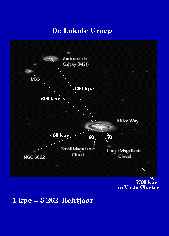
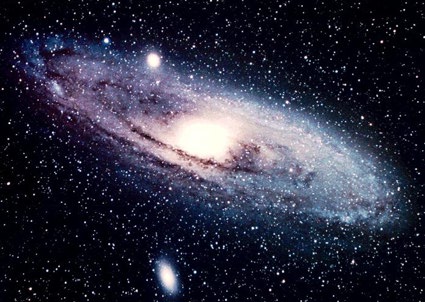
Name Coordinates Type D(kpc) Mv Vo(km/s)
M31 NGC 224 00 40.0 +40 59 Sb 725 -21.1 -299
Galaxy 17 42.4 -28 55 Sbc -20.6
M33 NGC 598 01 31.1 +30 24 Sc 795 -18.9 -180
LMC 05 24.0 -69 48 Irr 49 -18.1 270
IC 10 00 17.7 +59 01 Irr 820 -17.6 -343
NGC 6822 DDO 209 19 42.1 -14 56 Irr 540 -16.4 -49
M32 NGC 221 00 40.0 +40 36 E2 725 -16.4 -190
NGC 205 00 37.6 +41 25 E5 725 -16.3 -239
SMC 00 51.0 -73 06 Irr 58 -16.2 163
NGC 3109 DDO 236 10 00.8 -25 55 Irr 1260 -15.8 403
NGC 185 00 36.2 +48 04 E3 620 -15.3 -208
IC 1613 DDO 8 01 02.2 +01 51 Irr 765 -14.9 -236
NGC 147 DDO 3 00 30.5 +48 14 E4 589 -14.8 -157
Sextans A DDO 75 10 08.6 -04 28 Irr 1450 -14.4 325
Sextans B DDO 70 09 57.4 +05 34 Irr 1300 -14.3 301
WLM DDO 221 23 59.4 -15 45 Irr 940 -14.0 -116
Sagittarius 18 51.9 -30 30 dE7 24 -14.0 140
Fornax 02 37.8 -34 44 dE3 131 -13.0 53
Pegasus DDO 216 23 26.1 +14 28 Irr 759 -12.7 -181
Leo I DDO 74 10 05.8 +12 33 dE3 270 -12.0 285
Leo A DDO 69 09 56.5 +30 59 Irr 692 -11.7 +26
And II 01 13.5 +33 09 dE3 587 -11.7
And I 00 43.0 +37 44 dE0 790 -11.7
SagDIG 19 27.9 -17 47 Irr 1150 -11.0 -79
Antlia 10 01.8 -27 05 dE3 1150 -10.7 361
Sculptor 00 57.6 -33 58 dE 78 -10.7 107
And III 00 32.6 +36 12 dE6 790 -10.2
Leo II DDO 93 11 10.8 +22 26 dE0 230 -10.2 76
Sextans 10 10.6 -01 24 dE4 90 -10.0 224
Phoenix 01 49.0 -44 42 Irr 390 -9.9 56
LGS 3 01 01.2 +21 37 Irr/dE 760 -9.7 -277
Tucana 22 38.5 -64 41 dE5 900 -9.6
Carina 06 40.4 -50 55 dE4 87 -9.2 223
Ursa Minor DDO 199 15 08.2 +67 23 dE5 69 -8.9 -250
Draco DDO 228 17 19.2 +57 58 dE3 76 -8.6 -289
..............................................................
More M31 companions recently announced:
And V 01074+4721
And VI Peg Dw 23492+2419
And VII Cass Dw 23241+5025
..............................................................
Probable additional Local Group members:
IC 5152 21 59.6 -51 32 Irr 1600: +121
UKS 2323-326 23 23.8 -32 40 Irr 1300: +62
Aquarius 20 44.2 -13 01 Irr 900: -131
..............................................................
Nearby Galaxies just outside ? Local Group:
EGB0427+63 UGC-A92 04 27.4 +63 30 Irr 2000: -105
Cam A 04 31.5 +71 25 Irr 2000:
GR 8 DDO 155 12 56.2 +14 29 Irr 2200 -12.5 +216
Argo 07 04.5 -58 27 Irr 3500: 554
NB. does not include Sculptor Group direction objects
..............................................................

Back to R.A. Jansen's homepage
Go to the top of this page.
